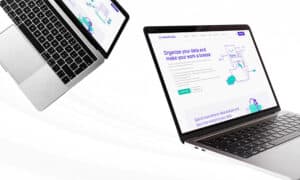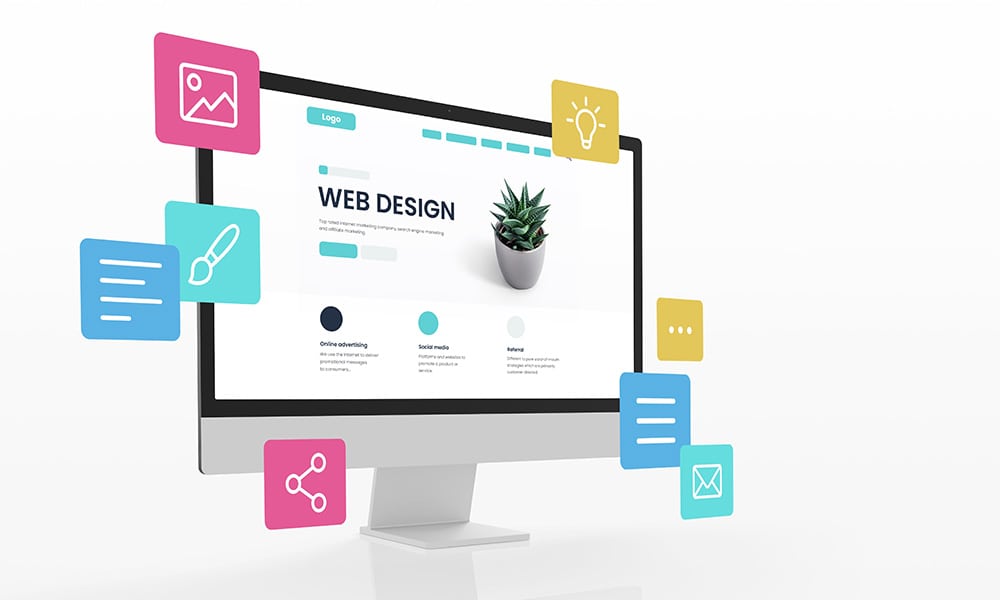Embracing the Future: An In-depth Exploration of Web Design Trends in 2023
Web design, the digital embodiment of businesses, significantly influences user experience. As 2023 progresses, we observe a surge of cutting-edge web design trends. These trends focus on enhancing interactivity, engagement, and customization for the contemporary user. Let’s delve deep into these influential trends revolutionizing the digital world.
1. Experimental Navigation: Beyond the Norm:
Traditional top-of-the-screen navigation is evolving. Experimental navigation crafts distinctive, imaginative pathways for users. It goes beyond mere placement to the essence of user interaction. For instance, Kim Kneipp’s portfolio infuses navigation with storytelling, transitioning the entire browsing experience into a branded odyssey.
- Understanding It: While traditional navigation was predominantly at the top, experimental navigation challenges norms, integrating navigation creatively.
- Advantages: It provides a distinct user experience, differentiating from competitors. It enriches storytelling and branding, ensuring an unforgettable browsing journey.
2. Dynamic Scrolling Effects: Revolutionizing Content Presentation
Scrolling effects, animations triggered by scrolling, have transformed content portrayal. Websites, like Engineered Floors, employ both horizontal and vertical scrolling, intensifying user experience depth and dynamism.
- Understanding It: Animations or effects initiated when a user scrolls a webpage.
- Advantages: They steer users through a narrative, amplifying engagement, making content resonate, and the website feels alive, responding to user movements.
3. Kinetic Typography in Web Design: Text on the Move
Although moving text isn’t a novel concept, its integration into web design imparts a dynamic flair to websites. Platforms like Arcadia employ it to captivate and seamlessly guide users.
- Understanding It: Animated text utilized innovatively in web design.
- Advantages: It commands attention, accentuates content, navigates users, and infuses energy into static content.
4. Drag Interaction: Empowering User Control
Web interactions are undergoing evolution, with drag interactions epitomizing this transformation. Websites now empower users with drag-and-drop capabilities, offering a tangible digital interaction. Robin Mastromarino’s portfolio exemplifies this tactile experience.
- Understanding It: Enabling users to directly interact with elements through dragging.
- Advantages: It imparts control to users, streamlining navigation and interactions, potentially augmenting user engagement and contentment.
5. The Power of Structured Typography: Words That Command
Typography communicates profoundly. Structured typography, characterized by robust shapes and capitalized letters, exudes stability and order, echoing the post-pandemic era’s craving for clarity.
- Understanding It: Employing solid shapes and capitalized letters for design emphasis.
- Advantages: It enhances readability, directs attention, and radiates authority and lucidity.
6. Cinemographs: Breathing Life into Staticity
Cinemographs, looping videos or GIFs, have carved a niche in enlivening static web pages, captivating users with their subtle motion.
- Understanding It: Looping videos or GIFs woven into web design.
- Advantages: They enrich pages with depth and interest, retaining attention more effectively than stationary images, without consuming excessive bandwidth.
7. Brutalism: A Bold Design Rebellion
Brutalism in web design embodies raw, audacious, and unrefined designs. It’s a refreshing deviation from overly polished templates.The brutalism that became mainstream in 2018 saw a shift in 2019, with designs becoming more user-centric and emotionally engaging. See how brutalism was introduced in 2018 and how it transformed in 2019.
- Understanding It: Bold, unrefined designs challenging conventional design tenets.
- Advantages: They command attention, resonating with users seeking authenticity and audacity.

8. Colorful Gradients: Vivid Color Transitions
2023 sees the ascendancy of multi-colored gradients, adding depth and visual allure, making content stand out vibrantly. While vibrant colors dominated the design landscape in 2019, the color palettes in 2023 have evolved to be more muted and natural. Explore the vibrant color trends of 2019 here
- Understanding It: Seamless color transitions in design elements.
- Advantages: Gradients infuse depth, highlight elements, and direct user focus.
9. Layering: Introducing Dimensionality
Layering, whether it’s with colors, images, or animations, grants websites a multi-dimensional aura, enriching content presentation.
- Understanding It: Overlapping design elements to craft a layered effect.
- Advantages: It creates depth and structure, rendering content more captivating.
10. The Text-Only Minimalist Approach: A Clarity Focus
Amidst visual inundation, certain websites are championing a text-centric approach, offering a refined, uncluttered user experience.
- Understanding It: Predominantly text-based websites, minimizing distractions.
- Advantages: They ensure rapid loading and a crystal-clear message, simplifying content assimilation.
11. Animated Illustrations: Artful Narratives
Animated illustrations transcend mere decoration. They simplify complex narratives, adding charm and weaving stories, elevating the entire website experience. Like we did with Mozart Data.
- Understanding It: Moving illustrations that narrate stories and concepts.
- Advantages: They distill complex narratives, emotionally resonate with users, and bestow unique charm on websites.
12. Ultra-minimalism: The Essence of Simplicity
Ultra-minimalism refines minimalist design, focusing on the indispensable, presenting content devoid of distractions.
- Understanding It: Stripping designs to their bare essentials.
- Advantages: Such sites minimize distractions, spotlighting core content and optimizing loading speeds.
13. Mixing Text Directions: A Visual Delight
Integrating horizontal and vertical text presents content refreshingly, adding an unexpected twist to the traditional reading flow.
- Understanding It: Melding horizontal and vertical text elements.
- Advantages: It disrupts conventional reading patterns, introducing novel engagement elements.
14. Geometric Shapes and Patterns: Playful Precision
Geometric designs infuse websites with a playful, structured ambiance, guiding attention and introducing an element of delight.
- Understanding It: Integrating playful geometric designs into web layouts.
- Advantages: They rejuvenate sites, guide focus, and break design monotony.
15. Web Textures: Tangibility in the Virtual World
Web textures mimic 3D surfaces, rendering a palpable digital sensation, making the online experience more engrossing.
- Understanding It: Design elements that replicate 3D textures.
- Advantages: Textures lend a tangible feel, enhancing immersion and tactile engagement.
Conceptualizing Interactive Features in 2023’s Web Design
One of the standout features of 2023’s web design trends is the emphasis on interactivity. While we can’t showcase live interactive elements here, let’s conceptualize how they’re transforming user experiences:
- Dynamic User Experiences: Imagine a website where the layout, color scheme, and even content adjust based on your preferences. For instance, a ‘Dark Mode’ that’s not just about dimming the brightness but also rearranging content for nighttime reading. This level of customization ensures every user gets a unique and tailored browsing experience.
- Responsive Sliders: Visualize sliders that don’t just transition images but reshape content. Sliding could reveal how a minimalist design transforms into a maximalist one, or how flat designs are evolving into 3D visuals. It’s all about guiding the user through a visual journey of design evolution.
- Tailored Infographics: Think of infographics that change based on user input. Want to know more about kinetic typography? The infographic zooms and reshapes to provide detailed insights into that specific trend, pushing other trends to the background.
- Dynamic Scrolling Effects: Nike’s official website showcases this trend effectively. As users scroll through their latest product launches, animations and product details are triggered, creating an immersive shopping experience.
- Kinetic Typography: Netflix utilizes kinetic typography in its promotional web banners. The animated text not only captures attention but also emphasizes the mood and theme of their latest shows and movies.
- Drag Interaction: Trello, a popular project management tool, has always been at the forefront of drag-and-drop capabilities. Their entire interface is built around the concept, allowing users to manage tasks seamlessly.
- Brutalism: Balenciaga, the luxury fashion brand, embraced brutalism with its raw and audacious website design. It stands out, making a bold statement in the fashion industry.
- Colorful Gradients: Instagram’s logo and branding revolve around a vibrant gradient, which is also reflected in their app design. This trend adds depth and visual allure, making content and icons pop.
- Experimental Navigation: Spotify recently revamped its web player, introducing a unique navigation system. Instead of the traditional top-bar navigation, they’ve integrated a dynamic sidebar that adjusts based on user activity, enhancing user experience and content discoverability.
By examining how these industry leaders are implementing the latest web design trends, we can gain insights into the practical applications and benefits of each trend. These real-world examples not only validate the trends but also offer inspiration for how they can be integrated effectively. While these features represent the future of web design, they also underline the importance of user-centric designs. It’s all about creating a dynamic, engaging, and personalized web experience for every individual user.
Conclusion 2023 marks a pivotal year for web design. Merging novel trends with the reemergence of familiar ones, the digital domain is now more vibrant and user-focused. By imbibing these trends, brands can develop an online marketing strategy that’s visually striking, interactive, engaging, and in sync with evolving user predilections.

